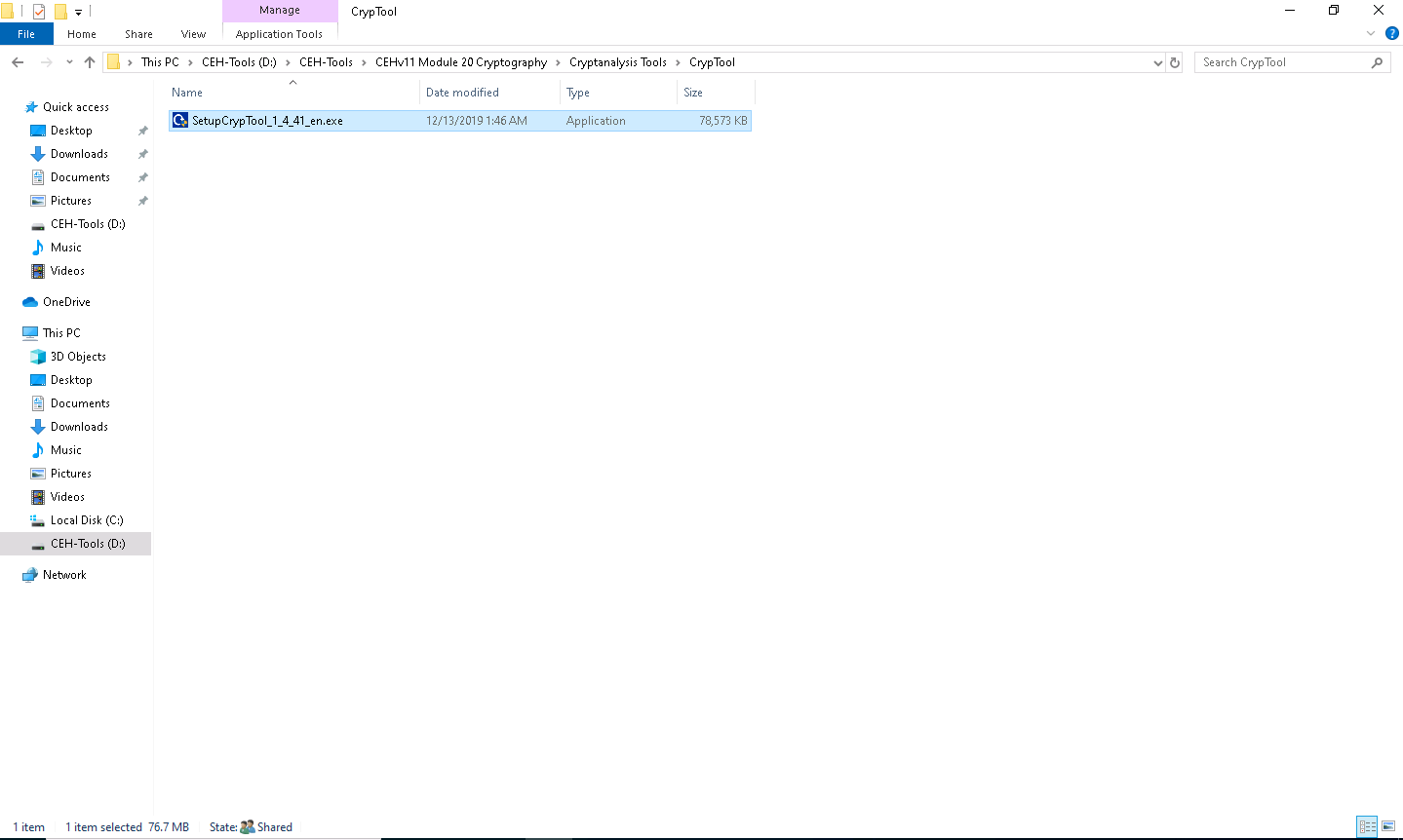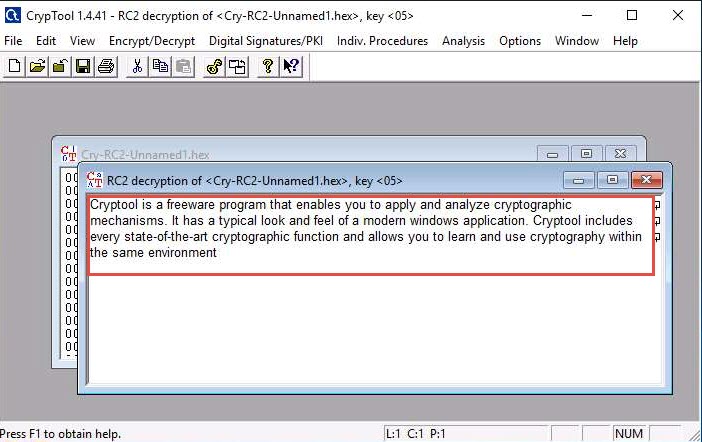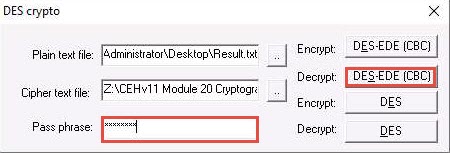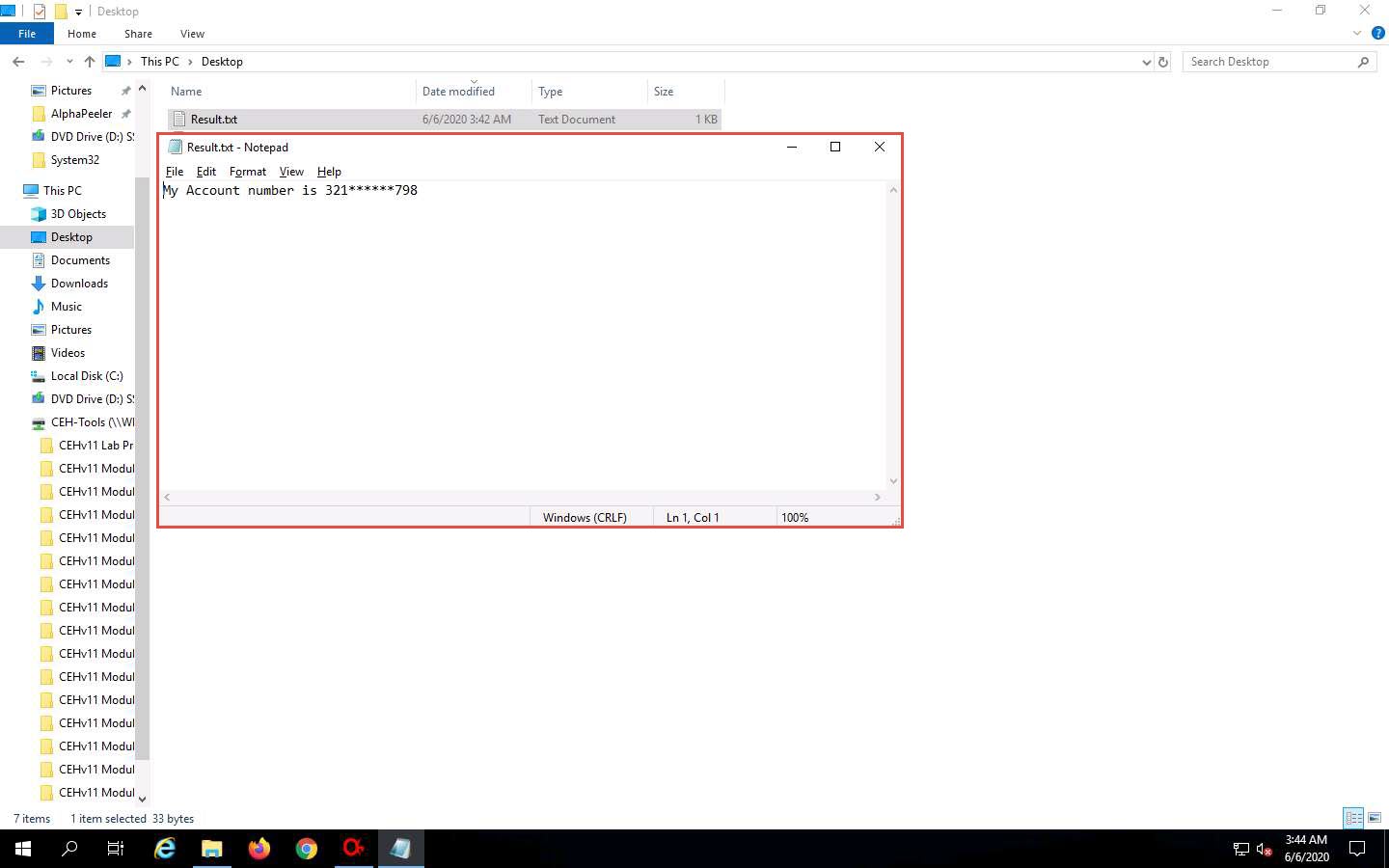Lab 5: Perform Cryptanalysis using Various Cryptanalysis Tools
Lab 5: Perform Cryptanalysis using Various Cryptanalysis Tools
Module 20: Cryptography
Lab 5: Perform Cryptanalysis using Various Cryptanalysis Tools
Task 1: Perform Cryptanalysis using CrypTool
CrypTool is a freeware program that enables you to apply and analyze cryptographic mechanisms, and has the typical look and
feel of a modern Windows application. CrypTool includes a multitude of state-of-the-art cryptographic functions and allows you
to both learn and use cryptography within the same environment. CrypTool is a free, open-source e-learning application used in
the implementation and analysis of cryptographic algorithms.
Here, we will use the CrypTool tool to perform cryptanalysis.
refer to blog little long
---------------------------------------------------------------------------------------------------------------------------------------
Module 20: Cryptography
Lab 5: Perform Cryptanalysis using Various Cryptanalysis Tools
Task 2: Perform Cryptanalysis using AlphaPeeler
AlphaPeeler is a powerful tool for learning cryptology. It can be useful as an instructor’s teaching aid and to create
assignments for classical cryptography. You can easily learn classical techniques such as frequency analysis of alphabets,
mono-alphabetic substitution, Caesar cipher, transposition cipher, Vigenere cipher, and Playfair cipher. AlphaPeeler Professional
(powered by crypto++ library) also includes DES, Gzip/Gunzip, MD5, SHA-1, SHA-256, RIPEMD-16, RSA key generation, RSA crypto, RSA
signature & validation, and generation of secret share files.
Here, we will use the AlphaPeeler tool to perform cryptanalysis.
refer to blog little long
Lab Scenario
Attackers tends to focus on easy to compromise targets. Therefore, in order to attain maximum network security, strong encryption is needed for all the traffic placed onto the transmission media, no matter the type and location: if an attacker wishes to break into an encrypted network, he/she faces decrypting a whole slew of encrypted packets, which is a difficult task. Therefore, the attacker is likely to try and find another target that is easy to compromise or will simply abort the attempt. Using the latest encryption algorithms provides a strong layer of security to an organization.
As a professional ethical hacker or pen tester, you should possess the required knowledge to investigate the security of cryptographic systems. In order to confirm the security of the cryptographic systems, you must implement various cryptography attacks to evade the system’s security by exploiting vulnerabilities in codes, ciphers, cryptographic protocols, or key management schemes.
In this lab, you will learn how to compromise cryptographic systems using various cryptanalysis techniques and tools that help in breaching cryptographic security.
Lab Objectives
- Perform cryptanalysis using CrypTool
- Perform cryptanalysis using AlphaPeeler
Overview of Cryptanalysis
Cryptanalysis can be performed using various methods, including the following:
- Linear Cryptanalysis: A known plaintext attack that uses a linear approximation to describe the behavior of the block cipher
- Differential Cryptanalysis: The examination of differences in an input and how this affects the resultant difference in the output
- Integral Cryptanalysis: This attack is useful against block ciphers based on substitution-permutation networks and is an extension of differential cryptanalysis
Task 1: Perform Cryptanalysis using CrypTool
CrypTool is a freeware program that enables you to apply and analyze cryptographic mechanisms, and has the typical look and feel of a modern Windows application. CrypTool includes a multitude of state-of-the-art cryptographic functions and allows you to both learn and use cryptography within the same environment. CrypTool is a free, open-source e-learning application used in the implementation and analysis of cryptographic algorithms.
Here, we will use the CrypTool tool to perform cryptanalysis.
In the Windows 10 machine. Navigate to D:\CEH-Tools\CEHv11 Module 20 Cryptography\Cryptanalysis Tools\CrypTool and double-click SetupCrypTool_1_4_41_en.exe.
If a User Account Control pop-up appears, click Yes.

The CrypTool Setup window appears; then, click Next.

Follow the wizard-driven installation steps to install the application using all default settings.
After the completion of the installation, the Completing CrypTool Setup wizard appears; uncheck the Show Readme checkbox and click Finish.

The CrypTool main window appears with a How to Start window. Check the Don’t show this dialog again checkbox and click Close.

The CrypTool window appears; close the startingexample-en.txt window.

Click the File option from the menu bar and select New to create encrypted data.

The Unnamed1 notepad appears; insert some text into the file. You will be encrypting this content.
From the menu bar, click Encrypt/Decrypt and navigate to Symmetric (modern) --> RC2….
RC2 is a symmetric-key block cipher. It is a 64-bit block cipher with variable key size and uses 18 rounds.

The Key Entry: RC2 dialog box appears; keep the Key length set to default (8 bits).
In the text field below Key length, enter 05 as hexadecimal characters, and click Encrypt.
The chosen hexadecimal character acts as a key that you must send to the intended user along with the encrypted file.

The RC encryption of Unnamed1 notepad file appears, as shown in the screenshot.

To save, click File in the menu bar and select Save.

The Save As window appears; choose the save location (here, Desktop) and click Save.
The file name may differ in your lab environment.

Now, you can send this file to the intended person by email or any other means and provide him/her with the hex value, which will be used to decrypt the file.
To share the file, you may copy the encrypted file (Cry-RC2-Unnamed1.hex) from Desktop to D:\CEH-Tools\CEHv11 Module 20 Cryptography\Cryptanalysis Tools\CrypTool.

Assume that you are the intended recipient (working on Windows Server 2019) of the encrypted file through the shared network drive and the key to open the encrypted data was sent to you via an email. Using this, you can decrypt the encrypted data and see the data in plain-text.
Click on Windows Server 2019 to switch to the Windows Server 2019, click Ctrl+Alt+Delete to activate the machine. By default, Administrator profile is selected, click on Pa$$w0rd to enter password in the password field and press Enter to login.

Navigate to Z:\CEHv11 Module 20 Cryptography\Cryptanalysis Tools\CrypTool, double-click SetupCrypTool_1_4_41_en.exe, and follow the steps to install the application using all default settings.

After the installation finishes, launch the CrypTool application.
In the How to Start dialog-box; check Don’t show this dialog again and click Close.
The CrypTool main window appears; close the startingexample-en.txt window.
Now, copy the encrypted hex file (Cry-RC2-Unnamed1.hex) from Z:\CEHv11 Module 20 Cryptography\Cryptanalysis Tools\CrypTool and paste it on Desktop.

Switch to the CrypTool window; click File in the menu bar and select Open…

The Open window appears; select Binary file (*.hex) from the drop-down list in the file type option, navigate to the location of the file (here, Desktop), select, and then click Open.

From the menu bar, click Encrypt/Decrypt and navigate to Symmetric (modern) --> RC2…

The Key Entry: RC2 dialog box appears; leave the Key length set to default (8 bits).
In the text field below Key length, enter 05 as hexadecimal characters, and click Decrypt.

The decrypted text appears, as shown in the screenshot:

Now, we shall encrypt the data using Triple DES encryption.
Click Windows 10 to switch back to the Windows 10 machine.
In the CrypTool window, close Cry-RC2-Unnamed1.hex window. Leave the Unnamed1 notepad window open.
From the menu bar, click Encrypt/Decrypt and navigate to Symmetric (modern) --> Triple DES (ECB)…

The Key Entry: Triple DES (ECB) dialog-box appears; leave the Key length set to default (128 bits (effectively 112 bits)).
In the text field below Key length, enter the combinations of 12 as hexadecimal characters, and click Encrypt.
The chosen hexadecimal characters act like a key that you must send to the intended user along with the encrypted file.

The Triple DES (ECB) encryption of Unnamed1 notepad appears, as shown in the screenshot.

To save the file, click File in the menu bar and select Save.
The Save As window appears; choose the save location (here, Desktop) and click Save.
The file name may differ in your lab environment.

To share the file, you may copy the encrypted file (Cry-Triple-Unnamed1.hex) from Desktop to D:\CEH-Tools\CEHv11 Module 20 Cryptography\Cryptanalysis Tools\CrypTool.

Click Windows Server 2019 to switch to Windows Server 2019; copy the encrypted hex file (Cry-Triple-Unnamed1.hex) from Z:\CEHv11 Module 20 Cryptography\Cryptanalysis Tools\CrypTool and paste on Desktop.

Switch to the CrypTool window to decrypt the data; click File in the menu bar and select Open…

The Open window appears; select Binary file (*.hex) from the drop-down list in the file type option, navigate to the location of the file (here, Desktop), select, and click Open.

From the menu bar, click Encrypt/Decrypt and navigate to Symmetric (modern) -- > Triple DES (ECB)…

The Key Entry: Triple DES (ECB) dialog-box appears; keep the Key length set to default (128 bits (effectively 112 bits)).
In the text field below Key length, enter the combinations of 12 as hexadecimal characters and click Decrypt.

The decrypted text appears, as shown in the screenshot.

Using this method, files can be encrypted using CrypTool and shared with an individual in a secure manner, so that no one can intercept the data.
This concludes the demonstration of performing cryptanalysis using CrypTool.
Close all open windows and document all the acquired information.
Task 2: Perform Cryptanalysis using AlphaPeeler
AlphaPeeler is a powerful tool for learning cryptology. It can be useful as an instructor’s teaching aid and to create assignments for classical cryptography. You can easily learn classical techniques such as frequency analysis of alphabets, mono-alphabetic substitution, Caesar cipher, transposition cipher, Vigenere cipher, and Playfair cipher. AlphaPeeler Professional (powered by crypto++ library) also includes DES, Gzip/Gunzip, MD5, SHA-1, SHA-256, RIPEMD-16, RSA key generation, RSA crypto, RSA signature & validation, and generation of secret share files.
Here, we will use the AlphaPeeler tool to perform cryptanalysis.
Click on Windows 10 to switch to the Windows 10 machine, navigate to D:\CEH-Tools\CEHv11 Module 20 Cryptography\Cryptanalysis Tools\AlphaPeeler and double-click AlphaPeelerPro1.3wse.exe.
If an Open File - Security Warning pop-up appears, click Run.

The AlphaPeeler Professional window appears; click Accept.

Follow the steps in the wizard and install the application using all default settings.
After the completion of the installation, click the Start icon from the bottom-left corner of Desktop and click AlphaPeeler from the applications.

AlphaPeeler Professional initializes and the AlphaPeeler main window appears, as shown in the screenshot.

Now, minimize the AlphaPeeler window and create a text file on Desktop. Name it Test, open the file, and insert some text.
Click File in the menu bar and click Save.

Switch back to the AlphaPeeler window; click Professional Crypto from the menu bar and select DES crypto from the options.

The DES crypto pop-up appears; click the ellipsis icon under the Plain text file option.

The Open window appears; navigate to Desktop and select Test.txt file; then, click Open.
Here, we are selecting the file that we will encrypt and this will act as an input file.

In the DES crypto pop-up; click the ellipsis icon under the Cipher text file option.
The Open window appears; select the save location (here, D:\CEH-Tools\CEHv11 Module 20 Cryptography\Cryptanalysis Tools\AlphaPeeler) and name the file as Confidential.txt; then, click Open.

In the DES crypto pop-up; insert the password into the Pass phrase field and click DES-EDE (CBC) to encrypt the text file.
Here, the password provided is test@123.

A new file Confidential.txt appears at location D:\CEH-Tools\CEHv11 Module 20 Cryptography\Cryptanalysis Tools\AlphaPeeler, as shown in the screenshot.
Double-click Confidential.txt to open, and you can observe that the file’s content is encrypted.
Here, the encrypted file is shared through shared network drive D:\CEH-Tools\ CEHv11 Module 20 Cryptography and the key to open the encrypted data was sent to you via an email. Using this, you can decrypt the encrypted data and view the data in plain-text.

Close the DES crypto pop-up and the AlphaPeeler window.
Click on Windows Server 2019 to switch to Windows Server 2019; navigate to Z:\CEHv11 Module 20 Cryptography\Cryptanalysis Tools\AlphaPeeler and copy the AlphaPeelerPro1.3wse.exe file on Desktop. Double-click AlphaPeelerPro1.3wse.exe file.
If an Open File - Security Warning pop-up appears, click Run.

Follow the steps in the wizard and install the application using all default settings.
After completion of the installation; click the Start icon from the bottom-right corner of Desktop and click AlphaPeeler from the applications.

The AlphaPeeler main window appears; click File from the menu bar and click Open…

The Open window appears; in the Look in field, navigate to the location of Z:\CEHv11 Module 20 Cryptography\Cryptanalysis Tools\AlphaPeeler and select Confidential.txt file; then, click Open.

The Confidential.txt file appears; click Professional crypto from the menu bar and select the DES crypto option.

The DES crypto pop-up appears; click the ellipsis icon next to the Plain text file option.

The Open window appears; navigate to Desktop and name the file Result.txt; then, click Open.
Here, we are creating an output file that will be in plain-text.
In the DES crypto pop-up; click the ellipsis icon under the Cipher text file option.
The Open window appears; select the encrypted file (Confidential.txt) located at Z:\CEHv11 Module 20 Cryptography\Cryptanalysis Tools\AlphaPeeler and click Open.

In the DES crypto pop-up, enter the password that you provided in Step#13 into the Pass phrase field and click the DES-EDE (CBC) button next to Decrypt to decrypt the text file.
Here, the password provided is test@123.

Navigate to Desktop and double click the Result.txt file. You can observe the file content in plain-text, as shown in the screenshot.

This concludes the demonstration of performing cryptanalysis using AlphaPeeler.
You can also use other cryptanalysis tools such as Cryptosense (https://cryptosense.com), RsaCtfTool (https://github.com), Msieve (https://sourceforge.net), and Cryptol (https://cryptol.net) to perform cryptanalysis.
Close all open windows and document all the acquired information.
Comments
Post a Comment